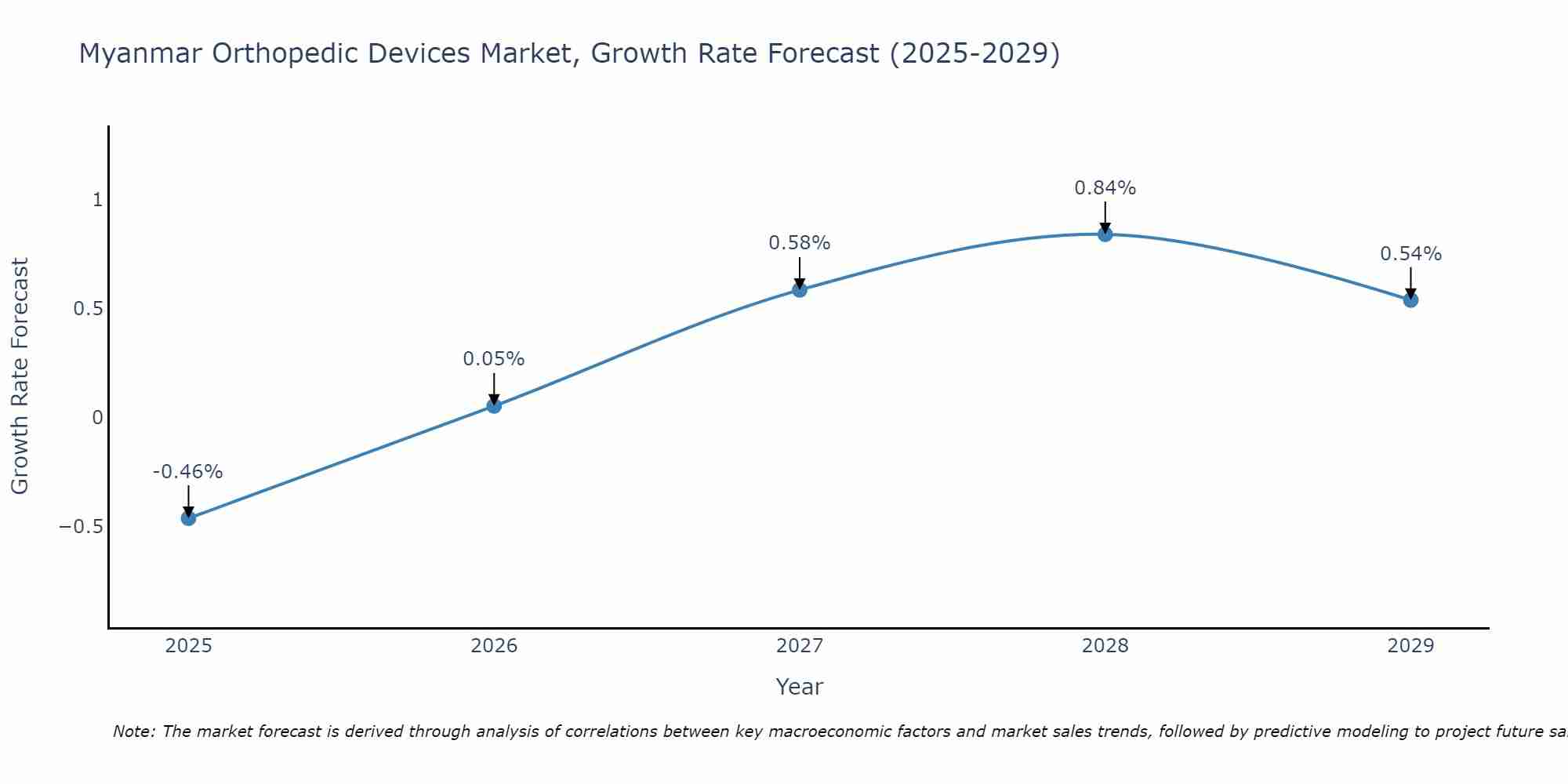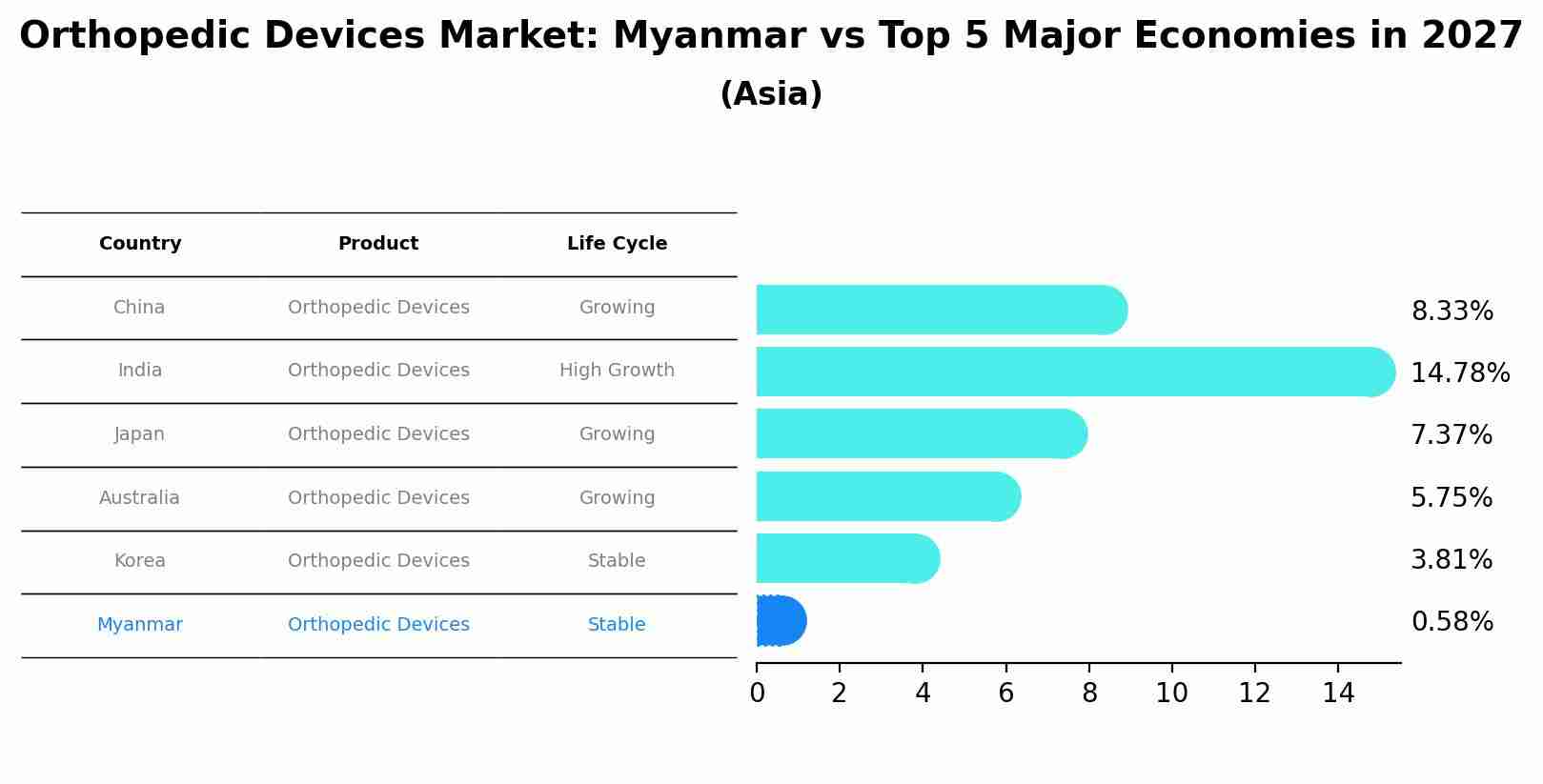Myanmar Orthopedic Devices Market (2025-2031) Outlook | Growth, Trends, Industry, Size, Forecast, Share, Analysis, Value, Companies & Revenue
| Product Code: ETC368134 | Publication Date: Aug 2022 | Updated Date: Jul 2025 | Product Type: Market Research Report | |
| Publisher: 6Wresearch | Author: Vasudha | No. of Pages: 75 | No. of Figures: 35 | No. of Tables: 20 |
Myanmar Orthopedic Devices Market Size Growth Rate
The Myanmar Orthopedic Devices Market is projected to witness mixed growth rate patterns during 2025 to 2029. Starting at -0.46% in 2025, the market peaks at 0.84% in 2028, and settles at 0.54% by 2029.

Orthopedic Devices Market: Myanmar vs Top 5 Major Economies in 2027 (Asia)
In the Asia region, the Orthopedic Devices market in Myanmar is projected to expand at a stable growth rate of 0.58% by 2027. The largest economy is China, followed by India, Japan, Australia and South Korea.

Myanmar Orthopedic Devices Market Synopsis
The Myanmar Orthopedic Devices Market is witnessing steady growth due to increasing awareness about orthopedic conditions and advancements in healthcare infrastructure. The market is primarily driven by the rising prevalence of musculoskeletal disorders, sports injuries, and the aging population. Key players in the market are offering a wide range of orthopedic devices including joint implants, trauma fixation devices, orthobiologics, and prosthetics to meet the growing demand for orthopedic treatments. However, challenges such as limited access to advanced orthopedic care in remote areas and the high cost of orthopedic devices hinder market growth. Despite these challenges, the Myanmar Orthopedic Devices Market is expected to expand further with the adoption of innovative technologies and increased investment in healthcare services.
Myanmar Orthopedic Devices Market Trends
The Myanmar Orthopedic Devices Market is witnessing a growing demand for minimally invasive procedures and technologically advanced orthopedic devices. This trend is driven by an increasing number of orthopedic surgeries in the country, coupled with a growing awareness among healthcare providers and patients about the benefits of minimally invasive techniques. Additionally, the rising prevalence of orthopedic disorders, such as osteoarthritis and fractures, is fueling the demand for innovative orthopedic devices that offer better outcomes and faster recovery times. Furthermore, the government`s efforts to improve healthcare infrastructure and expand access to orthopedic care are also contributing to the growth of the market. Overall, the Myanmar Orthopedic Devices Market is poised for significant expansion in the coming years, driven by these key trends.
Myanmar Orthopedic Devices Market Challenges
The Myanmar Orthopedic Devices Market faces several challenges, including limited access to advanced technologies and high-quality devices due to economic constraints and underdeveloped healthcare infrastructure. The market also struggles with a lack of skilled orthopedic professionals and inadequate training programs, leading to a shortage of expertise in the field. Regulatory barriers and import restrictions further hinder market growth and innovation. Additionally, the presence of counterfeit products poses a significant threat to patient safety and market credibility. Overall, overcoming these challenges requires significant investments in healthcare infrastructure, regulatory reforms, education and training programs, and collaborations with global manufacturers to ensure the availability of safe and effective orthopedic devices in Myanmar.
Myanmar Orthopedic Devices Market Investment Opportunities
The Myanmar orthopedic devices market presents promising investment opportunities due to the country`s growing healthcare sector and increasing demand for advanced medical technologies. With a rising prevalence of orthopedic conditions and a growing elderly population, there is a need for innovative orthopedic devices such as joint replacement implants, trauma fixation devices, and orthobiologics. Investing in the distribution of high-quality orthopedic devices, establishing partnerships with local healthcare providers, and offering training programs for healthcare professionals can help tap into this market. Additionally, exploring opportunities in telemedicine and digital health solutions to improve access to orthopedic care in remote areas can also be a strategic investment move in Myanmar.
Jordan Agar Market Government Policies
The government of Myanmar has implemented various policies related to the orthopedic devices market in the country. These policies include regulations for the registration and approval of orthopedic devices to ensure quality and safety standards are met. The government also encourages local manufacturing of orthopedic devices through incentives and support programs to reduce reliance on imported products. Additionally, there are guidelines in place for the pricing and reimbursement of orthopedic devices to make them more accessible to the population. Overall, the government`s policies aim to promote the growth of the orthopedic devices market in Myanmar while ensuring the availability of high-quality and affordable products for patients in need of orthopedic treatments.
Myanmar Orthopedic Devices Market Future Outlook
The Myanmar Orthopedic Devices Market is poised for significant growth in the coming years due to factors such as the increasing prevalence of orthopedic disorders, rising geriatric population, and improving healthcare infrastructure in the country. The market is expected to be driven by the demand for joint reconstruction devices, spinal implants, and trauma fixation products. Additionally, the growing awareness about advanced orthopedic treatments and the adoption of technologically advanced devices are likely to further fuel market expansion. However, challenges such as limited access to healthcare services in rural areas and regulatory hurdles may impact market growth to some extent. Overall, the Myanmar Orthopedic Devices Market presents substantial opportunities for both domestic and international manufacturers in the foreseeable future.
Key Highlights of the Report:
- Myanmar Orthopedic Devices Market Outlook
- Market Size of Myanmar Orthopedic Devices Market, 2024
- Forecast of Myanmar Orthopedic Devices Market, 2031
- Historical Data and Forecast of Myanmar Orthopedic Devices Revenues & Volume for the Period 2021 - 2031
- Myanmar Orthopedic Devices Market Trend Evolution
- Myanmar Orthopedic Devices Market Drivers and Challenges
- Myanmar Orthopedic Devices Price Trends
- Myanmar Orthopedic Devices Porter's Five Forces
- Myanmar Orthopedic Devices Industry Life Cycle
- Historical Data and Forecast of Myanmar Orthopedic Devices Market Revenues & Volume By Application for the Period 2021 - 2031
- Historical Data and Forecast of Myanmar Orthopedic Devices Market Revenues & Volume By Hip Orthopedic Devices for the Period 2021 - 2031
- Historical Data and Forecast of Myanmar Orthopedic Devices Market Revenues & Volume By Knee Orthopedic Devices for the Period 2021 - 2031
- Historical Data and Forecast of Myanmar Orthopedic Devices Market Revenues & Volume By Spine Orthopedic Devices for the Period 2021 - 2031
- Historical Data and Forecast of Myanmar Orthopedic Devices Market Revenues & Volume By Craniomaxillofacial Orthopedic Devices for the Period 2021 - 2031
- Historical Data and Forecast of Myanmar Orthopedic Devices Market Revenues & Volume By Dental Orthopedic Devices for the Period 2021 - 2031
- Historical Data and Forecast of Myanmar Orthopedic Devices Market Revenues & Volume By Sports Injuries, Extremities And Trauma (Set) Orthopedic Devices for the Period 2021 - 2031
- Historical Data and Forecast of Myanmar Orthopedic Devices Market Revenues & Volume By Product for the Period 2021 - 2031
- Historical Data and Forecast of Myanmar Orthopedic Devices Market Revenues & Volume By Drill Guide for the Period 2021 - 2031
- Historical Data and Forecast of Myanmar Orthopedic Devices Market Revenues & Volume By Guide Tubes for the Period 2021 - 2031
- Historical Data and Forecast of Myanmar Orthopedic Devices Market Revenues & Volume By Implant Holder for the Period 2021 - 2031
- Historical Data and Forecast of Myanmar Orthopedic Devices Market Revenues & Volume By Custom Clamps for the Period 2021 - 2031
- Historical Data and Forecast of Myanmar Orthopedic Devices Market Revenues & Volume By Distracters for the Period 2021 - 2031
- Historical Data and Forecast of Myanmar Orthopedic Devices Market Revenues & Volume By Screw Drivers for the Period 2021 - 2031
- Historical Data and Forecast of Myanmar Orthopedic Devices Market Revenues & Volume By Accessories for the Period 2021 - 2031
- Myanmar Orthopedic Devices Import Export Trade Statistics
- Market Opportunity Assessment By Application
- Market Opportunity Assessment By Product
- Myanmar Orthopedic Devices Top Companies Market Share
- Myanmar Orthopedic Devices Competitive Benchmarking By Technical and Operational Parameters
- Myanmar Orthopedic Devices Company Profiles
- Myanmar Orthopedic Devices Key Strategic Recommendations
Frequently Asked Questions About the Market Study (FAQs):
- Single User License$ 1,995
- Department License$ 2,400
- Site License$ 3,120
- Global License$ 3,795
Search
Related Reports
- Vietnam System Integrator Market (2025-2031) | Size, Companies, Analysis, Industry, Value, Forecast, Growth, Trends, Revenue & Share
- ASEAN and Thailand Brain Health Supplements Market (2025-2031) | Strategy, Consumer Insights, Analysis, Investment Trends, Opportunities, Growth, Size, Share, Industry, Revenue, Segments, Value, Segmentation, Supply, Forecast, Restraints, Outlook, Competition, Drivers, Trends, Demand, Pricing Analysis, Competitive, Strategic Insights, Companies, Challenges
- ASEAN Bearings Market (2025-2031) | Strategy, Consumer Insights, Analysis, Investment Trends, Opportunities, Growth, Size, Share, Industry, Revenue, Segments, Value, Segmentation, Supply, Forecast, Restraints, Outlook, Competition, Drivers, Trends, Demand, Pricing Analysis, Competitive, Strategic Insights, Companies, Challenges
- Europe Flooring Market (2025-2031) | Outlook, Share, Industry, Trends, Forecast, Companies, Revenue, Size, Analysis, Growth & Value
- Saudi Arabia Manlift Market (2025-2031) | Outlook, Size, Growth, Trends, Companies, Industry, Revenue, Value, Share, Forecast & Analysis
- Uganda Excavator, Crane, and Wheel Loaders Market (2025-2031) | Strategy, Consumer Insights, Analysis, Investment Trends, Opportunities, Growth, Size, Share, Industry, Revenue, Segments, Value, Segmentation, Supply, Forecast, Restraints, Outlook, Competition, Drivers, Trends, Demand, Pricing Analysis, Competitive, Strategic Insights, Companies, Challenges
- Rwanda Excavator, Crane, and Wheel Loaders Market (2025-2031) | Strategy, Consumer Insights, Analysis, Investment Trends, Opportunities, Growth, Size, Share, Industry, Revenue, Segments, Value, Segmentation, Supply, Forecast, Restraints, Outlook, Competition, Drivers, Trends, Demand, Pricing Analysis, Competitive, Strategic Insights, Companies, Challenges
- Kenya Excavator, Crane, and Wheel Loaders Market (2025-2031) | Strategy, Consumer Insights, Analysis, Investment Trends, Opportunities, Growth, Size, Share, Industry, Revenue, Segments, Value, Segmentation, Supply, Forecast, Restraints, Outlook, Competition, Drivers, Trends, Demand, Pricing Analysis, Competitive, Strategic Insights, Companies, Challenges
- Angola Excavator, Crane, and Wheel Loaders Market (2025-2031) | Strategy, Consumer Insights, Analysis, Investment Trends, Opportunities, Growth, Size, Share, Industry, Revenue, Segments, Value, Segmentation, Supply, Forecast, Restraints, Outlook, Competition, Drivers, Trends, Demand, Pricing Analysis, Competitive, Strategic Insights, Companies, Challenges
- Israel Intelligent Transport System Market (2025-2031) | Strategy, Consumer Insights, Analysis, Investment Trends, Opportunities, Growth, Size, Share, Industry, Revenue, Segments, Value, Segmentation, Supply, Forecast, Restraints, Outlook, Competition, Drivers, Trends, Demand, Pricing Analysis, Competitive, Strategic Insights, Companies, Challenges
Industry Events and Analyst Meet
Our Clients
Whitepaper
- Middle East & Africa Commercial Security Market Click here to view more.
- Middle East & Africa Fire Safety Systems & Equipment Market Click here to view more.
- GCC Drone Market Click here to view more.
- Middle East Lighting Fixture Market Click here to view more.
- GCC Physical & Perimeter Security Market Click here to view more.
6WResearch In News
- Doha a strategic location for EV manufacturing hub: IPA Qatar
- Demand for luxury TVs surging in the GCC, says Samsung
- Empowering Growth: The Thriving Journey of Bangladesh’s Cable Industry
- Demand for luxury TVs surging in the GCC, says Samsung
- Video call with a traditional healer? Once unthinkable, it’s now common in South Africa
- Intelligent Buildings To Smooth GCC’s Path To Net Zero













